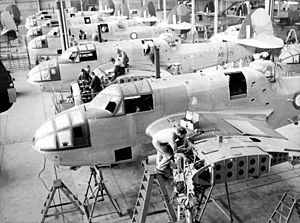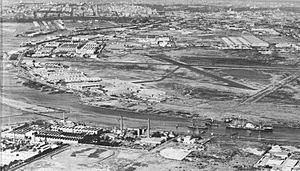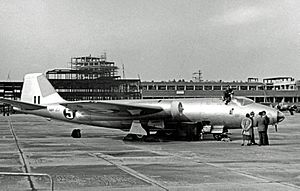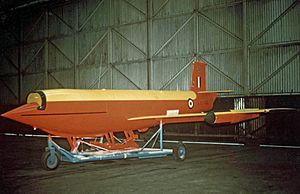Government Aircraft Factories facts for kids

Main entrance to the Government Aircraft Factories at Fishermans Bend in 1985
|
|
| Industry | Aircraft manufacturing |
|---|---|
| Fate | Incorporated as ASTA and ultimately acquired by Boeing Australia |
| Founded | 1 July 1939 in Melbourne, Australia |
| Headquarters |
Port Melbourne
,
Australia
|
| Products | GAF Jindivik GAF Nomad |
The Government Aircraft Factories (GAF) was an important company in Australia. It made airplanes and was owned by the Australian government. GAF was located in Fishermans Bend, a suburb of Melbourne, Victoria.
The company started just before World War II in 1939. Back then, it was called the Department of Aircraft Production (DAP). In 1987, GAF changed its name to Aerospace Technologies of Australia (ASTA). Later, ASTA was sold to a private company. It eventually became part of Boeing Australia, a big aerospace company.
Contents
History of GAF
Starting During World War II
The Australian government realized it needed to make its own airplanes. This was because it might not be able to get planes from other countries during World War II. So, on July 1, 1939, they created a new group. This group was called the Aircraft Construction Branch. Its main job was to build the Bristol Beaufort bomber plane.
At that time, Australia didn't have a big airplane industry. Companies like Commonwealth Aircraft Corporation and de Havilland Australia made some planes. But these were mostly smaller, simpler aircraft. The Beaufort was a large, advanced metal plane. It was a big step for Australian manufacturing.
The government ordered 180 Beaufort planes in July 1939. These planes were for both the Royal Australian Air Force (RAAF) and the Royal Air Force (RAF). The group making the planes changed its name a few times. By 1941, it was known as the Department of Aircraft Production (DAP). The actual plane-making part was called the Beaufort Division.
The Australian Beauforts used different engines than the original British ones. This meant the design had to be changed. Also, some parts that were supposed to come from Britain couldn't. This was due to the war. So, these parts had to be made in Australia instead. For example, Australia didn't make ball bearings at the time. They had to find a local way to make them for the planes.
The first Australian-built Beaufort flew in August 1941. Many different companies helped build these planes. The DAP mostly did the final assembly. Other factories made major parts. For example, train workshops and the General Motors Holden factory helped. By August 1944, 700 Beauforts had been built. This was a huge number for Australia.
After the Beaufort, the DAP started making the Bristol Beaufighter. This plane was a multi-role fighter. Building the Beaufighter went more smoothly. This was because the same companies helped again. The first DAP Beaufighter flew in May 1944. The war ended before all planned Beaufighters were finished. In total, 365 were built.
After the War
After World War II, the Australian aviation industry became much smaller. The DAP was reorganized and got its most famous name: the Government Aircraft Factories (GAF).
One of the first planes GAF built after the war was the Avro Lincoln bomber. The first one flew in 1946. GAF built 68 of these large planes.
From 1953, GAF also built 48 English Electric Canberra jet bombers. These were powerful planes. Many of them were used by the RAAF in the Vietnam War. Some were later changed to be used for training pilots.
In 1958, GAF created something new: the GAF Jindivik. This was a jet-powered target drone. A drone is an uncrewed aircraft. The Jindivik was used to practice shooting down enemy planes. It could land on skids and be used again. It was used by Australia and the United Kingdom.
End of GAF
In 1987, the Government Aircraft Factories changed its name to Aerospace Technologies of Australia (ASTA). In 1995, ASTA was sold to a private company. Today, Aerospace Technologies of Australia is part of Boeing Australia.
Planes and Products Made by GAF
GAF made many different aircraft and missiles, including:
- Bristol Beaufort bomber
- Bristol Beaufighter multi-role fighter
- Avro Lincoln bomber
- English Electric Canberra jet bomber
- GAF Pika (an early manual drone)
- GAF Jindivik (a remote-controlled jet drone)
- Malkara missile (a guided anti-tank missile)
- Ikara missile (a guided anti-submarine missile)
- GAF Turana drone (a target drone)
- Dassault Mirage III jet fighter (GAF assembled these)
- GAF Nomad STOL aircraft (a small plane that can take off and land in short distances)
- McDonnell Douglas F/A-18 Hornet jet fighter (GAF assembled most of these)
- AAC Wamira trainer (a planned training aircraft)





